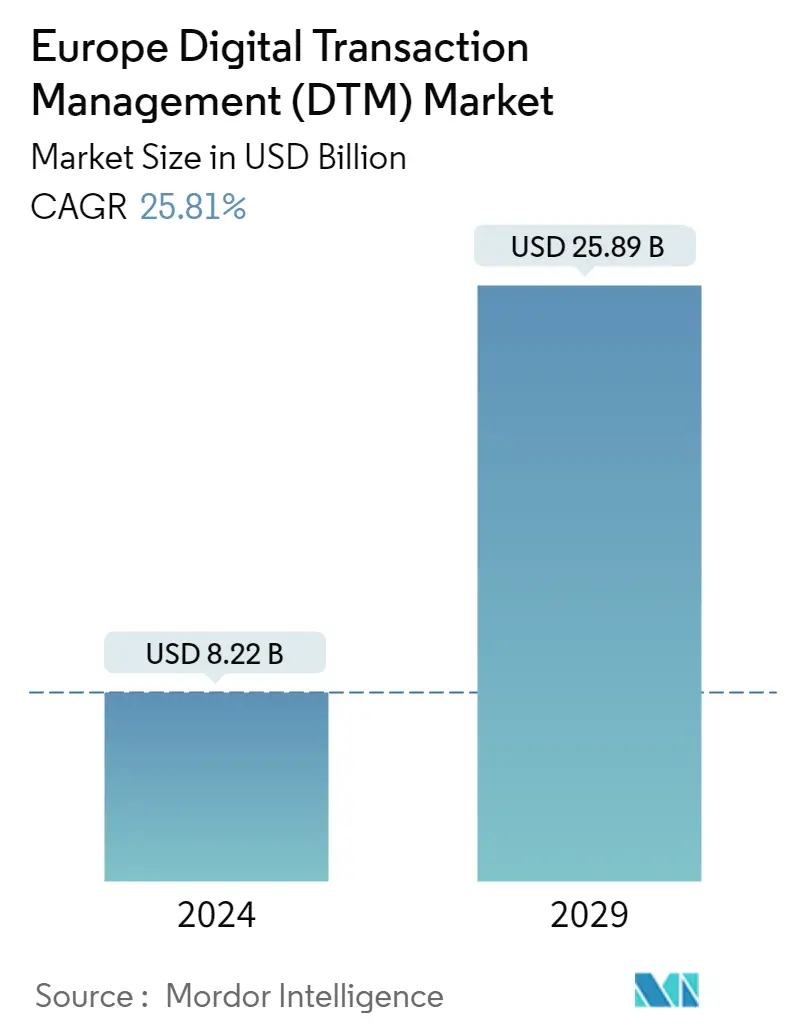Market Size of Europe Digital Transaction Management (DTM) Industry

| Study Period | 2019 - 2029 |
| Base Year For Estimation | 2023 |
| Market Size (2024) | USD 8.22 Billion |
| Market Size (2029) | USD 25.89 Billion |
| CAGR (2024 - 2029) | 25.81 % |
| Market Concentration | Medium |
Major Players
*Disclaimer: Major Players sorted in no particular order |
Need a report that reflects how COVID-19 has impacted this market and its growth?
Europe Digital Transaction Management (DTM) Market Analysis
The Europe Digital Transaction Management Market size is estimated at USD 8.22 billion in 2024, and is expected to reach USD 25.89 billion by 2029, growing at a CAGR of 25.81% during the forecast period (2024-2029).
The ongoing focus on automation of businesses is expected to provide lucrative opportunities for market growth. The adoption of digital transaction management is significantly driven by the client's requirements for business automation. Basic e-signatures can substantially reduce the time taken to get contracts signed. It is also crucial to automate the entire document lifecycle, to fully digitalize business processes to get faster outcomes.
- Vendors provide digital transaction management solutions closely integrated with business automation solutions. For instance, Intesa, an IBM company, provides digital transaction management solutions to dematerialize critical business processes. The company offers a single platform that automates, maintains transactional and documental flows, and guarantees their legal validity with the electronic signature, thus managing the entire document lifecycle.
- DTM use is accelerating and is predicted to replace numerous aspects of paper documentation eventually. Most businesses are turning to digital platforms and e-signatures to boost income and profitability. Risks such as tampering or fraud of documents are very high during financial transactions. By using a digital signature, the chances are reduced.
- The adoption of cloud-based e-signature among enterprises for managing and protecting their critical data is also propelling market growth, thereby fuelling the requirement for digital signatures. Salesforce, for example, used digital transaction management and saw a USD 20 per-document savings and a 60 percent reduction in turnaround times. The company also included electronic signatures into their sales process, which reduced deal closing times from an average of two days to about 90% of deals closing in one day and 71% closing in one hour.
- The transaction volumes in the digital realm are annually increasing, and organizations convert all forms of transactions to a digital format. As time goes by, more and more B2B businesses and vendors are moving toward using virtual cards and then automating them, raising the demand for business automation. The industries are compelled to embrace digital technology to continue their business due to the rising obligations related to online and remote work. The government is supporting digital modes of signature and verification like smart ID/card readers, smooth passes, electronic signatures, biometric signatures, and others to propel digital transactions.
- Moreover, many European businesses already use Advanced E-Signatures in enforceable agreements and contracts with customers and business partners. In 2021, in the digital policy announcement, the European Union proposed creating a framework for a trusted and secure European e-ID (digital identity). The EU wants all citizens, residents, and businesses to be able to use a national digital identity to prove who they are to access public sector or commercial services, regardless of where they are in the bloc. Such instances are expected to drive the growth of the market.
- The pandemic has spurred financial inclusion, driving a significant increase in digital payments amid the expansion of formal financial services. This expansion created new economic opportunities. Additionally, certain risks are associated, such as cyber risks and digital fraudulence, which are likely to restrict the growth of the DTM market.
- With the outbreak of COVID-19, the DTM market is expected to exhibit growth in Europe due to the rise in remote working that has shifted focus on relying on paper-based documentation and increasing digitalization of the transaction process. The pandemic also accelerated the digitalization of payments, including transfers initiated via online banking, a mobile banking app, or an automated transfer. Such transactions in Europe have emerged the need for DTM Solutions.
